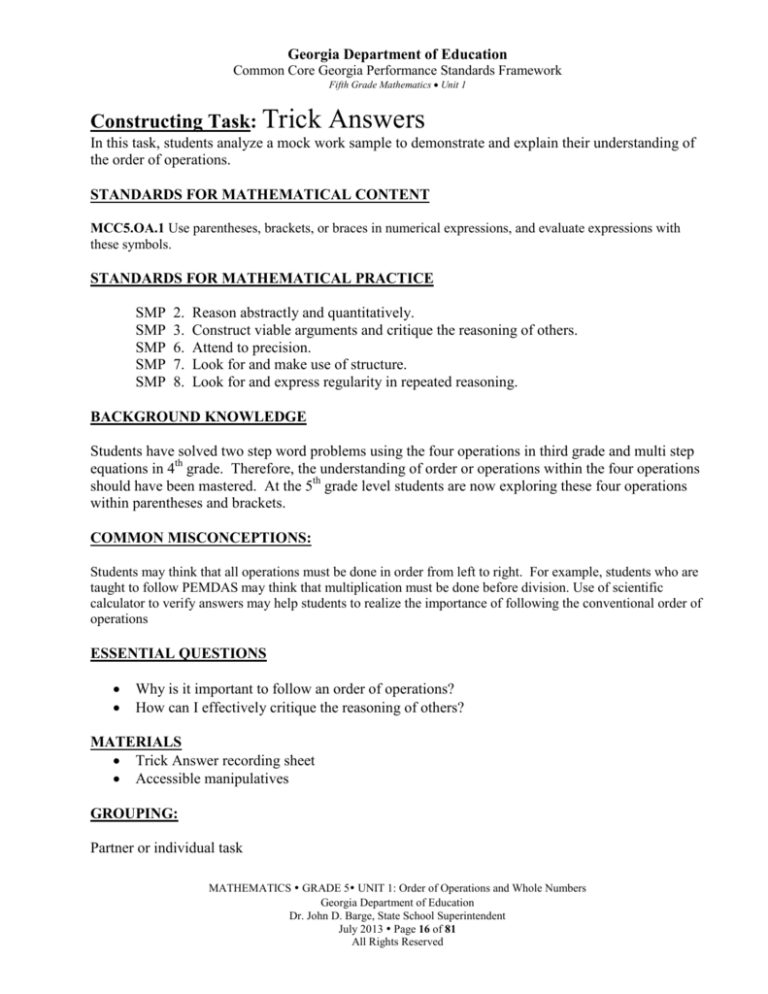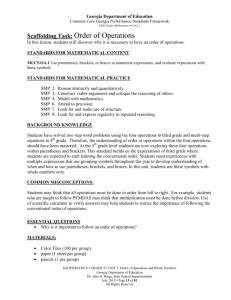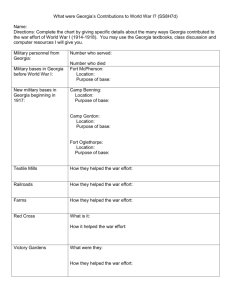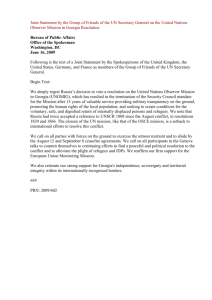
Georgia Department of Education
Common Core Georgia Performance Standards Framework
Fifth Grade Mathematics Unit 1
Constructing Task: Trick
Answers
In this task, students analyze a mock work sample to demonstrate and explain their understanding of
the order of operations.
STANDARDS FOR MATHEMATICAL CONTENT
MCC5.OA.1 Use parentheses, brackets, or braces in numerical expressions, and evaluate expressions with
these symbols.
STANDARDS FOR MATHEMATICAL PRACTICE
SMP
SMP
SMP
SMP
SMP
2.
3.
6.
7.
8.
Reason abstractly and quantitatively.
Construct viable arguments and critique the reasoning of others.
Attend to precision.
Look for and make use of structure.
Look for and express regularity in repeated reasoning.
BACKGROUND KNOWLEDGE
Students have solved two step word problems using the four operations in third grade and multi step
equations in 4th grade. Therefore, the understanding of order or operations within the four operations
should have been mastered. At the 5th grade level students are now exploring these four operations
within parentheses and brackets.
COMMON MISCONCEPTIONS:
Students may think that all operations must be done in order from left to right. For example, students who are
taught to follow PEMDAS may think that multiplication must be done before division. Use of scientific
calculator to verify answers may help students to realize the importance of following the conventional order of
operations
ESSENTIAL QUESTIONS
Why is it important to follow an order of operations?
How can I effectively critique the reasoning of others?
MATERIALS
Trick Answer recording sheet
Accessible manipulatives
GROUPING:
Partner or individual task
MATHEMATICS GRADE 5 UNIT 1: Order of Operations and Whole Numbers
Georgia Department of Education
Dr. John D. Barge, State School Superintendent
July 2013 Page 16 of 81
All Rights Reserved
Georgia Department of Education
Common Core Georgia Performance Standards Framework
Fifth Grade Mathematics Unit 1
TASK DESCRIPTION, DEVELOPMENT AND DISCUSSION:
Comments: Students should have an understanding of the order of operations through several
problem solving experiences before being given this task. Teachers can adjust this task based upon
the level of independence of their students with order of operations. For example, parenthesis can be
added to or removed from any of the problems. Also, it is possible to do this task multiple times in
order to introduce new order of operations concepts.
TASK:
Students will use the recording sheet to critique the answers on Sasha’s homework. They will share
their thinking, and discuss why Sasha might have missed the answer.
FORMATIVE ASSESSMENT QUESTIONS
What will you do to try to figure out if the answer given is correct?
How will you demonstrate that it is correct?
How will you convince Sasha when you think her answer is incorrect?
How can you explain your math reasoning clearly to your peers and teachers?
What strategies are you using to analyze the given problems?
What cues are you using to recognize the correct order of operations?
DIFFERENTIATION
Extension
To explore the complexities of order of operations, have students create and solve their
own numerical expressions and defend their solutions in writing.
Give students a number and ask them to create complex expressions equivalent to the
number. Encourage students to continually expand the expression as shown below:
17
10 + 7
(2 x 5) + 7
[2 x (30 ÷ 6)] + 7
[2 x (15 x 2 ÷ 6)] + 7
Create or add real life situations to expressions with more than 1 operation.
Create an expression from a real life situation involving more than one operation.
MATHEMATICS GRADE 5 UNIT 1: Order of Operations and Whole Numbers
Georgia Department of Education
Dr. John D. Barge, State School Superintendent
July 2013 Page 17 of 81
All Rights Reserved
Georgia Department of Education
Common Core Georgia Performance Standards Framework
Fifth Grade Mathematics Unit 1
Intervention
Help students who lack background knowledge in understanding these concepts by
limiting the number of operations and introducing them one at a time.
Teach students to group operations using the parentheses, even when they are not
included in the original problem. For example, if they see this problem:
6 + 5 x 10 – 4 ÷ 2
They can rewrite it like this:
6 + (5 x 10) – (4 ÷ 2)
In this way, the parentheses guide their work.
Using a Hop Scotch board like the one shown on the right is one
way to help students remember the order of operations.
Remembering the rules of Hop Scotch, one lands with both feet
on squares 3 & 4 and 6 & 7. This is used as a reminder to
students that multiplication and division computed in the order
in which they appear in the problem, left to right. The same is
true for addition and subtraction, which is also performed in the
order of appearance, left to right.
TECHNOLOGY CONNECTION
http://www.nzmaths.co.nz/resource/four-fourschallenge?parent_node= This link provides teachers with some
additional, student centered lessons to develop the concept of
order of operations.
MATHEMATICS GRADE 5 UNIT 1: Order of Operations and Whole Numbers
Georgia Department of Education
Dr. John D. Barge, State School Superintendent
July 2013 Page 18 of 81
All Rights Reserved
Georgia Department of Education
Common Core Georgia Performance Standards Framework
Fifth Grade Mathematics Unit 1
Name _______________________________ Date _____________
Trick Answers
You and your best friend, Sasha, sat down after school at your house to work on your math homework.
work for her and explain to her how you know her answers are correct or incorrect.
Sasha
1.
6 + 2 x 4 = 32
1a. If Sasha were to incorporate parentheses within her problem, where would she place
them?_____________________________________________________________
2. 24 – 8 + 6 ÷ 2 = 11
3. 30 ÷ (10 + 5) x 3 = 24
4. 3 x (18 – 3) + (6 + 4) ÷ 2 = 50
MATHEMATICS GRADE 5 UNIT 1: Order of Operations and Whole Numbers
Georgia Department of Education
Dr. John D. Barge, State School Superintendent
July 2013 Page 19 of 81
All Rights Reserved







